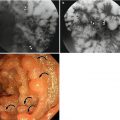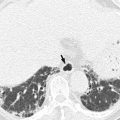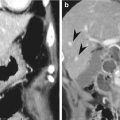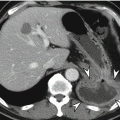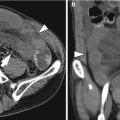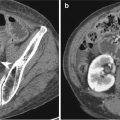Fig. 8.1
Mucosa-associated lymphoid tissue (MALT) lymphoma in a 56-year-old female. (a) Endoscopy reveals focal mucosal wall irregularity (arrow) of the stomach high body posterior wall. This lesion is confirmed as extranodal marginal zone B-cell lymphoma of MALT associated with H. pylori chronic active gastritis on endoscopic biopsy. (b) This lesion is not clearly visualized on the axial contrast-enhanced CT image. (c) On 3D shaded surface display (SSD), small mucosal irregularity lesion (arrow) is demonstrated at the stomach high body posterior wall side. (d) No perigastric lymphadenopathy is associated
8.3.2 Mucosa-Associated Lymphoid Tissue (MALT) Lymphoma
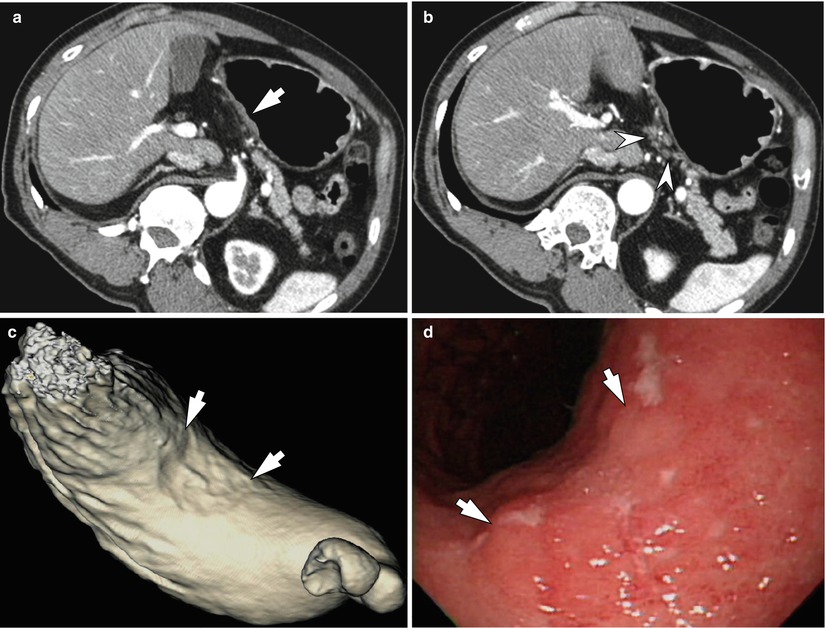
Fig. 8.2
Mucosa-associated lymphoid tissue (MALT) lymphoma in a 68-year-old male. (a, b) There is focal mild wall thickening at the stomach midbody lesser curvature (arrow) with several small enlarged lymph nodes (arrowheads) at the perigastric area on axial contrast-enhanced CT images. (c, d) Ill-defined geographic-shaped mucosal elevated lesion (arrows) is seen on 3D shaded surface display (SSD) (c) and endoscopy (d). This lesion is confirmed as extranodal marginal zone B-cell lymphoma of MALT and H. pylori infection is also associated
8.3.3 Mucosa-Associated Lymphoid Tissue (MALT) Lymphoma
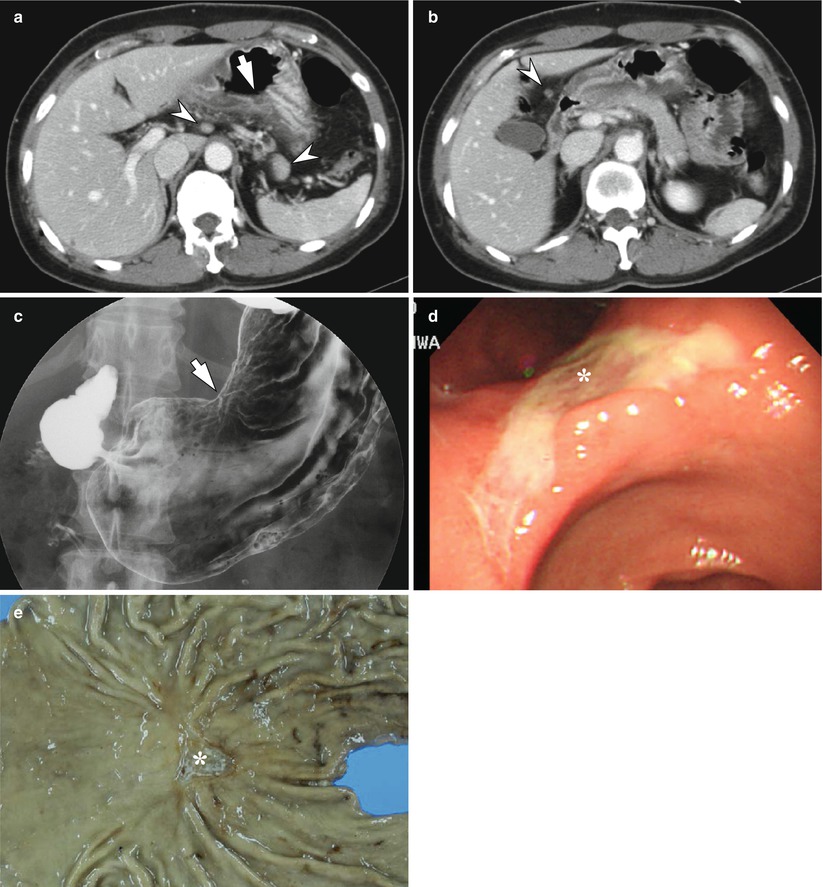
Fig. 8.3
Mucosa-associated lymphoid tissue (MALT) lymphoma in a 46-year-old female. (a, b) On axial contrast-enhanced CT images, small ulcerative lesion (arrow) with surrounding mild gastric wall thickening is noted in the low body to angle of the stomach. Several homogeneously enhancing perigastric lymph nodes (arrowheads) are also associated. (c) UGIS image depicts shallow ulcerative lesion (arrow) in the lesser curvature side of stomach angle. (d, e) On endoscopy (d) and surgical specimen (e) of the stomach subtotal gastrectomy, triangular-shaped ulcerative lesion (asterisk) is revealed. This lesion is confirmed as low-grade marginal zone B-cell lymphoma of MALT
8.3.4 Mucosa-Associated Lymphoid Tissue (MALT) Lymphoma
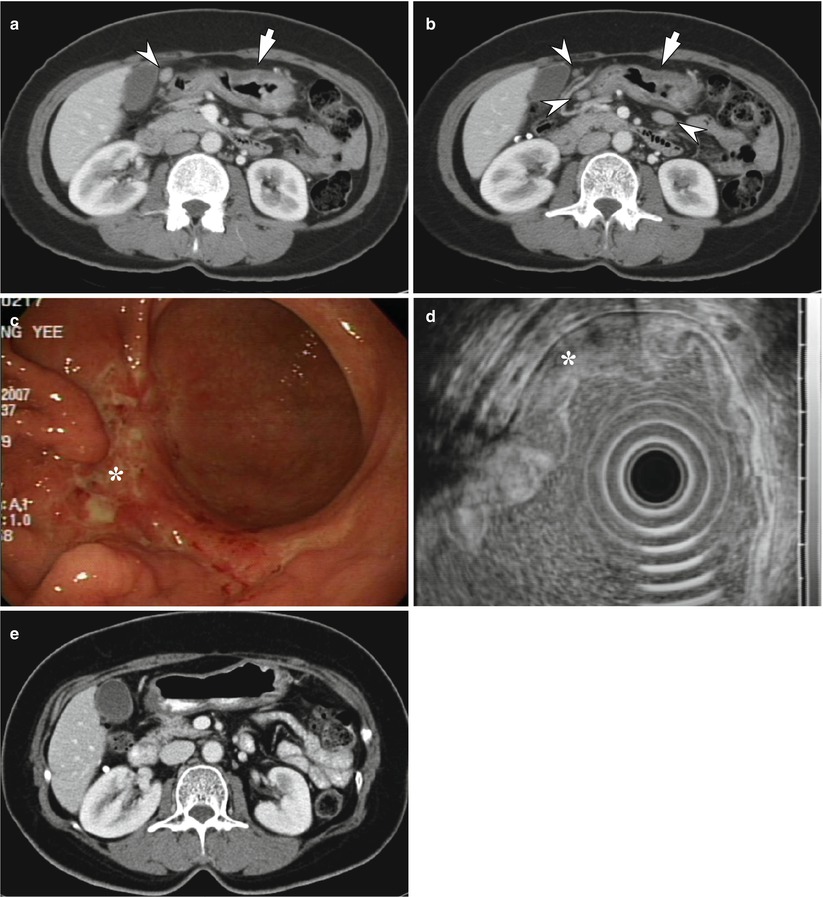
Fig. 8.4
Mucosa-associated lymphoid tissue (MALT) lymphoma in a 50-year-old female. (a, b) Segmental mild wall thickening with homogeneous low attenuation involving stomach low body anterior wall (arrows) is seen on axial contrast-enhanced CT images. Multiple homogeneously enhancing perigastric lymph nodes (arrowheads) are also demonstrated. (c, d) Endoscopy (c) shows geographic mucosal lesion (asterisk) with fused converging folds, and endoscopy-guided ultrasonography (d) also reveals segmental hypoechoic wall thickening (asterisk) of the stomach. Low-grade marginal zone B-cell lymphoma of MALT and H. pylori chronic active gastritis are confirmed. (e) After radiation therapy, previous gastric wall thickening and perigastric lymphadenopathy are improved on follow-up contrast-enhanced CT image
8.3.5 Mucosa-Associated Lymphoid Tissue (MALT) Lymphoma
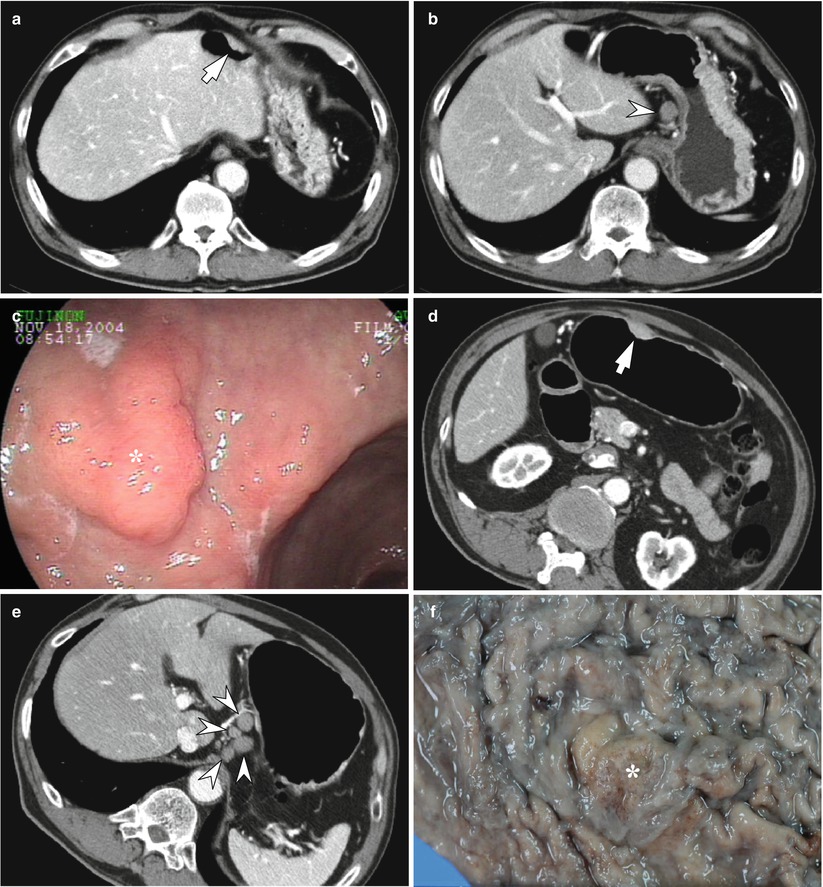
Fig. 8.5
Mucosa-associated lymphoid tissue (MALT) lymphoma in a 65-year-old male. (a, b) Axial contrast-enhanced CT images demonstrate small enhancing nodular lesion (a, arrow) in the stomach low body anterior wall and ovoid-shaped lymphadenopathy (b, arrowhead) at the left gastric area. (c) On endoscopy, small fungating mass (asterisk) is found in the stomach low body anterior wall, and it was confirmed as low-grade MALT lymphoma. (d, e) Despite medical treatment, the enhancing nodular lesion (d, arrow) in the stomach is slightly increased on follow-up CT images taken after 1 year. The number and size of the left gastric lymphadenopathy (e, arrowheads) are also increased. (f) The patient underwent total gastrectomy. The surgical specimen reveals fungating mass (asterisk)
8.3.6 Diffuse Large B-Cell Lymphoma (DLBL)
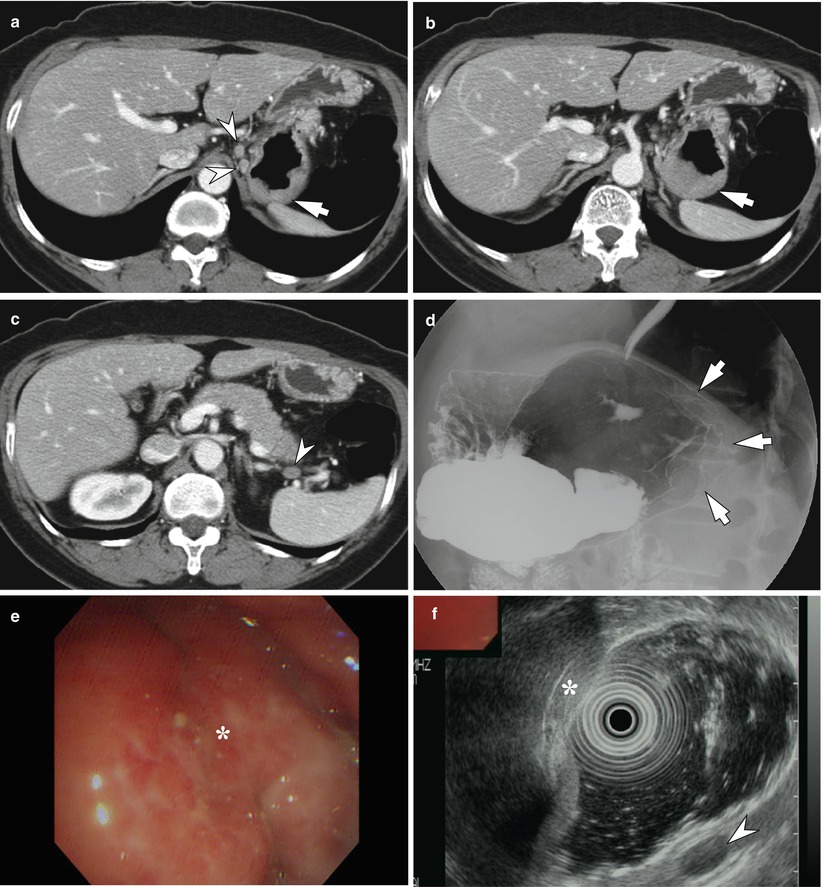
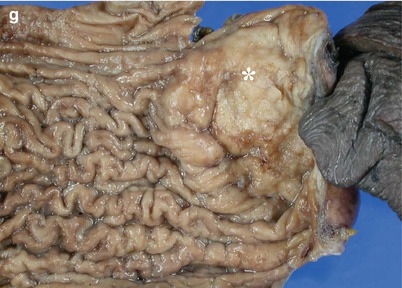
Fig. 8.6
Diffuse large B-cell lymphoma (DLBL) in a 63-year-old female. (a–c) Segmental homogeneous enhancing wall thickening (arrow) of the stomach fundus without perigastric fat infiltration is seen on the axial contrast-enhanced CT images. Several small perigastric lymph nodes (arrowheads) are associated. (d) UGIS image reveals thickened mucosal folds (arrows) involving the stomach fundus. (e, f) There is a protruding mass (asterisk) with intact gastric mucosa at the stomach fundus on endoscopy (e) and endoscopy-guided ultrasound (EUS) (f). Small hypoechoic perigastric enlarged lymph node (arrowhead) is also seen on EUS. (g) Surgical specimen demonstrates whitish mass (asterisk) in the stomach fundus, which is confirmed as DLBL
8.3.7 Diffuse Large B-Cell Lymphoma (DLBL) Mimicking Adenocarcinoma
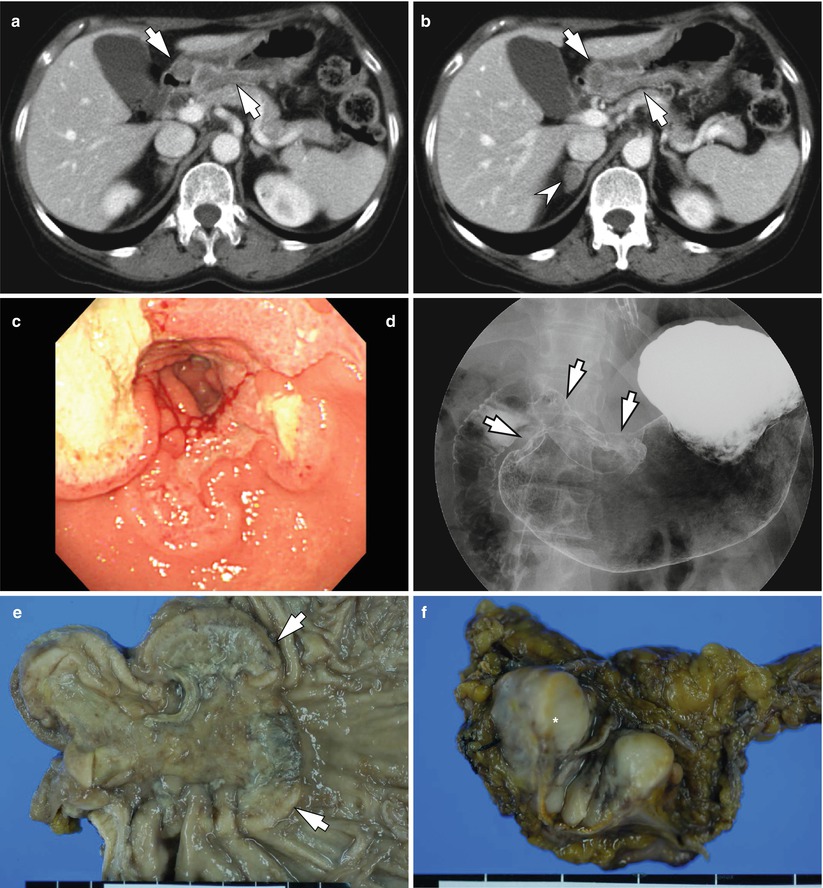
Fig. 8.7
Diffuse large B-cell lymphoma (DLBL) in a 63-year-old female. (a, b) Axial contrast-enhanced CT images show segmental low-attenuated wall thickening (arrows) involving the stomach angle to antrum. Perigastric fat plane is observed. Ovoid-shaped low-attenuated nodule (arrowhead) is seen at the right adrenal gland. (c) Geographic ulceroinfiltrative mass is seen in the stomach antrum on endoscopy. (d) UGIS image depicts ulceroinfiltrative mass (arrows) involving the stomach angle to antrum. The findings of endoscopy and UGIS for this lesion mimic advanced adenocarcinoma. (e, f) Two surgical specimens of distal gastrectomy and right adrenalectomy demonstrate ulceroinfiltrative mass (arrows) in the stomach and a small whitish solid mass (asterisk) in the right adrenal gland. They are confirmed as DLBL of the stomach and lymphoma involvement of the right adrenal gland
8.3.8 Diffuse Large B-Cell Lymphoma (DLBL) with Multiple Lesions
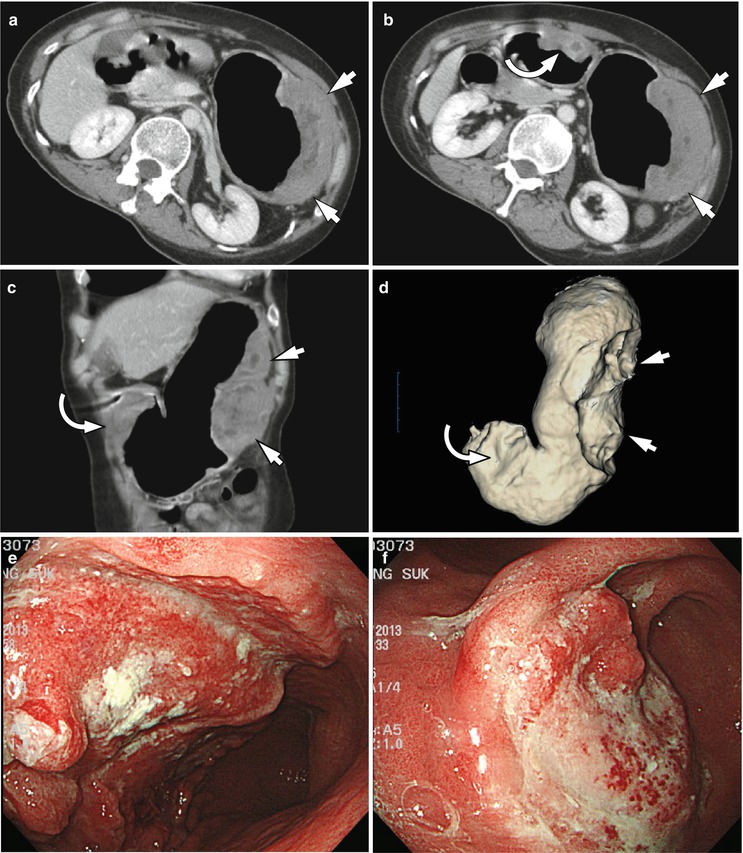
Fig. 8.8




Diffuse large B-cell lymphoma (DLBL) in a 54-year-old female. (a–c) Axial and coronal contrast-enhanced CT images show multiple mass-like segmental wall thickenings involving the stomach body (arrows) and antrum (curved arrow). The wall thickening is marked, and even though there are some focal low-attenuated portions of the thickened wall, the wall thickening is relatively homogeneous. No perigastric enlarged lymph node is seen. (d) 3D shaded surface display (SSD) image well demonstrates three mass-like gastric wall thickening lesions (arrows in the body greater curvature and curved arrow in the antrum anterior wall). (e, f) Two irregular ulceroinfiltrative masses are seen on endoscopy and are confirmed as DLBL on endoscopic biopsy
Stay updated, free articles. Join our Telegram channel

Full access? Get Clinical Tree



